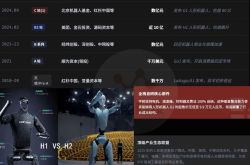Beyond the Capital Craze: The Valley of Despair and the Real Turning Point for Embodied AI
![]() 09/26 2025
09/26 2025
![]() 645
645
This marks my 389th column piece.
Lately, discussions and investments around 'embodied AI' have soared to unprecedented levels of 'frenzy'. Major corporations are placing substantial bets, venture capital circles are bustling with activity, and industry titans are vying alongside startups. Suddenly, 'embodied AI' has become the darling of both investors and the media. On the market, billion-dollar funding deals are popping up frequently, and the entire industry chain is abuzz with excitement, as if anyone who hesitates will miss out on the opportunities of this era.
Yet, amidst the hype, measured voices have not vanished.
As the Economic Daily cautions, 'Halt the rush towards 'AI+'.' This warning not only pinpoints the 'growing pains' of China's AI industry but also serves as a wake-up call for the current global race in embodied AI.
Driven by capital, policy, and technological advancements, we must pause and reflect: beyond 'funding fever' and 'celebrity companies,' what are the truly worthy long-term concerns and profound questions?
The surge in embodied AI indeed sparks imagination and industrial opportunities.
It signifies not only AI's shift from the virtual to the physical realm but is also seen as the 'next universal technology platform.' However, if we remain fixated on funding rankings, demo videos, and PPT presentations while overlooking innovation sustainability, technological realities, the health of the industrial ecosystem, and social ethical responsibilities, the so-called 'hype' will quickly dissipate like past tech bubbles, leading to even greater disappointment and resource wastage.
Hence, this article aims to transcend the superficial logic of 'capital frenzy' and 'track explosions,' instead delving into deeper and more sustainable topics such as technological innovation, industrial implementation, responsible governance, and social value.
Let us ponder amidst the excitement: What innovative ideas are worth considering amidst the hype? Beyond capital and technology, what kind of industrial patience and nurturing mechanisms do we need? Only in this way can the deep integration of AI and the physical world truly bear fruit.
Behind the Capital Craze: The Real Stratification of the Embodied AI Industry

The list goes on. From 2024 to 2025, the field of embodied AI has witnessed a rare collective capital frenzy, with single funding rounds repeatedly hitting new heights. 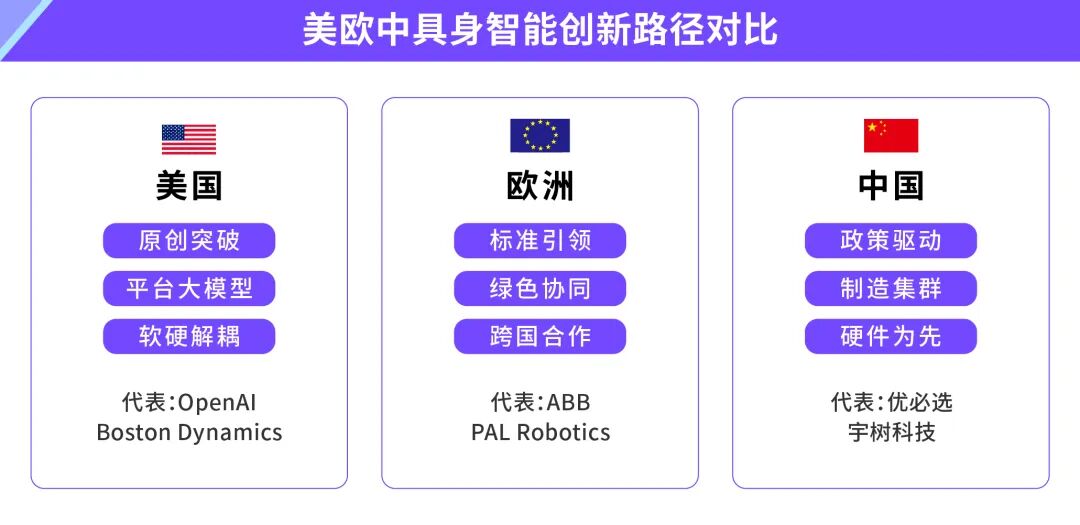
Whether it's Figure AI, 1X, and Boston Dynamics in the West or China's rising stars like Zhiyuan Robotics, Fourier Intelligence, and Unitree Technology, all are accelerating their expansion under the wave of capital, becoming the headline acts in industrial news.
Strategic partnerships between industry giants and innovative unicorns are frequently announced, with top resources rapidly converging on a few leading players. The Matthew effect intensifies across the industry chain, with 'head convergence and giant binding' becoming the main theme of this cycle.
Undeniably, China plays a pivotal role in the global development of embodied AI. According to McKinsey's analysis, at the current trajectory, the global market for embodied AI will reach $370 billion by 2040, with China accounting for 50% of the market share. 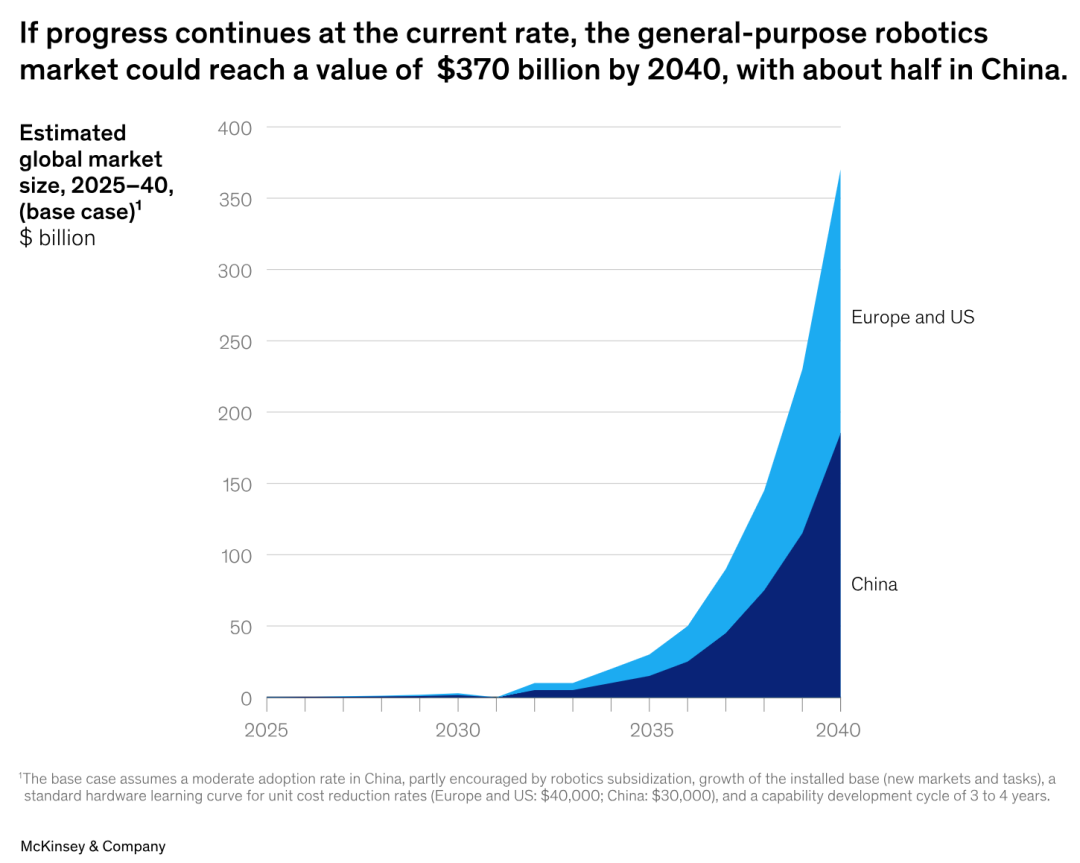
Yet, behind the excitement lies a harsher and more complex industry reality. With large capital inflows, the '80-20 divide' in the embodied AI field becomes increasingly pronounced.
Financed and resource-rich companies can rapidly expand their technical teams, tackle key challenges, increase market investments, and even pre-emptively position cross-border ecosystems. However, a large number of small and medium-sized enterprises are marginalized in this capital flood, with restricted R&D progress, tightened financing channels, and further compressed market spaces.
In a sense, the industry shakeout period has arrived. Surviving the cyclical fluctuations of capital becomes the key threshold for companies to 'thrive and endure'.
Capital accumulation and soaring valuations do not necessarily mean a simultaneous leap in innovation capabilities. Reviewing this wave of embodied AI funding, we see that a significant portion of funds flows toward 'scaled production,' 'market positioning,' and even 'star teams' themselves, while patient capital truly aimed at bottom-layer technological breakthroughs and long-term ROI remains scarce.
To date, commercially viable cases that can be called 'killer applications' are still few. Whether humanoid robots or multifunctional mobile platforms, most applications remain in small-scale pilot or demonstration stages.
'Funding fever ≠ innovation breakthrough' and 'Demo ≠ productivity' have become increasingly loud voices of reflection within the industry. While capital's push is important, only teams that truly navigate through industrial cycles, wait for technological maturity, and dare to deeply cultivate complex scenarios will stand firm in the next round of industrial upgrading.
The 'Spatial Revolution' of Embodied AI: From Stacking to Evolution 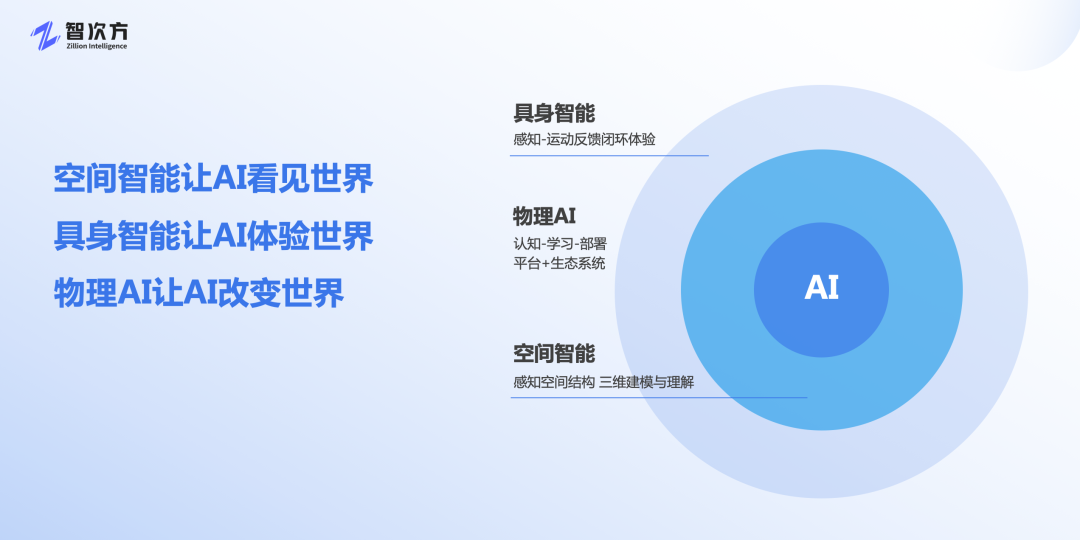
Any truly meaningful technological revolution extends far beyond 'functional additions' or simple stacking and upgrades. The latest breakthroughs in the field of embodied AI exemplify this.
The deepest innovations no longer lie in the mechanical combination of AI large models and hardware but stem from qualitative leaps in spatial intelligence, three-dimensional world generation, and multimodal perception and reasoning capabilities.
The diagram above outlines the evolutionary path of AI's ability to perceive the world and deeply integrate into and transform the physical world.
Spatial intelligence equips AI with the ability to understand and reconstruct three-dimensional spatial structures, effectively 'opening its eyes' to the world. Building on this, embodied AI enables dynamic interaction with the real environment through perception, movement, and feedback, truly 'experiencing' the world. Ultimately, physical AI represents AI's ability not only to perceive and learn but also to deploy and collaborate within complex platforms and ecosystems, driving profound changes in the real world.
Take World Labs, a pioneering project in spatial intelligence, as an example. AI systems have evolved to perform complex spatial cognition and dynamic reasoning based on multi-source inputs such as images, text, audio, and video. They not only 'see' but also 'understand the environment,' even capable of inferring and reconstructing complete three-dimensional world structures from a single two-dimensional image.
This leap in spatial perception and dynamic prediction capabilities provides a new universal foundation for industrial robots, virtual reality, autonomous driving, and other fields. It means machines are no longer passive 'mechanical bodies' but truly intelligent agents capable of 'self-adapting to the world.'
The rise of multimodal fusion and 'interactive intelligence' is propelling AI into a new developmental stage. Unlike traditional robots that process only single-sense information, today's embodied AI is evolving toward 'fully perceptive, fully conversational, and fully responsive' interactive intelligent agents.
AI now comprehends not just images or voices but integrates multiple signals to achieve natural language dialogue, environmental perception, instant responses, and dynamic adjustments for complex tasks. This multimodal cognitive ability is giving rise to a new breed of AI that is more 'actionable' and 'transferable' than ChatGPT.
More importantly, this revolution in spatial intelligence and multimodal cognition forces the industry to abandon the old path of 'stacking hardware and crunching parameters.' If China's embodied AI industry blindly pursues hardware scale expansion, parameter stacking, and PPT-driven innovation, it will ultimately miss the strategic window of global spatial intelligence and software-hardware synergy.
Truly internationally competitive 'digital labor' must evolve continuously through self-developed large models, simulation training, and open ecosystems. These are not 'human-like' robots but 'super assistants' capable of understanding space, transferring tasks, and adapting to contexts.
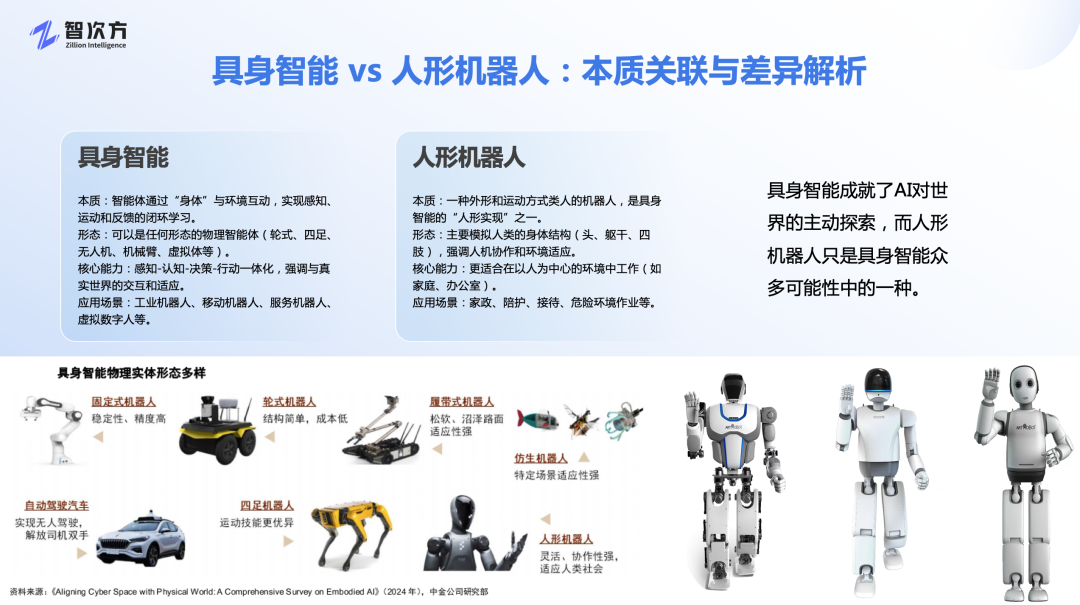
Embodied AI ≠ humanoid robots. The future of embodied AI lies not just in creating 'more human-like' robots but in building digital labor that understands the world, adapts to change, and unleashes creativity. This technological transformation from 'stacking' to 'leapfrogging' will be a critical variable for China's industry to break through international competition.
From Performance to Implementation: How Embodied AI Can Cross the 'Valley of Death'
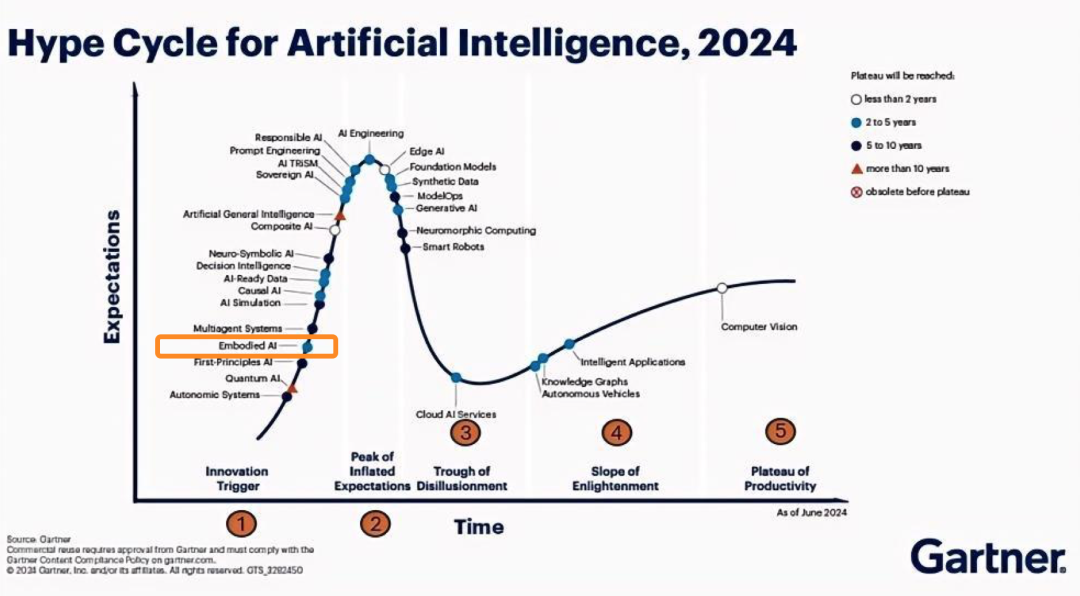
While the embodied AI industry is riding high, the gap between reality and imagination continues to widen.
According to Gartner's analysis, as shown above, embodied AI is in the early climbing stage of innovation, with at least 2-5 years remaining before application. The most common phenomenon in the industry is that dazzling demo videos far outnumber actual application value. Capital and media enthusiastically pursue newsworthy scenes like 'humanoid robots dancing' or 'dexterous hands folding paper,' yet few cases truly move toward mass production and social services.
Behind this lies a long and winding technological and commercial 'valley of death'—whether innovation can cross it determines the success and future of an industrial revolution.
Technological bottlenecks remain the first major hurdle for embodied AI. Whether it's battery life, dexterous hand precision, or the generalization ability of AI models, the industry faces real challenges. Even the world's top laboratories struggle to achieve 90% success rates in training scenarios, let alone the 99% stability required for industrial-grade applications.
Data shortcomings further constrain the continuous evolution of AI models, as the richness, complexity, and variability of the real world far exceed what simulation environments can easily replicate. These shortcomings directly lengthen ROI cycles and increase the difficulty of commercial implementation.
Under high expectations from capital and society, humanoid robots are burdened with too many fantasies of 'killer applications.' However, a calm observation reveals that truly customer-valuable scenarios are extremely limited. For many real-world tasks, traditional automation solutions are even more efficient and cost-effective than humanoid robots.
Whether in warehousing and logistics, manufacturing assembly, or healthcare, most current embodied AI products remain in 'small-batch pilot' or 'showroom demonstration' stages, with a long way to go before widely replacing human labor and driving societal productivity leaps.
A deeper challenge is that the industry may be at the threshold of a 'plateau period.' More and more experts are questioning whether current AI methodologies are sufficient to propel embodied AI across the commercialization threshold.
Without breakthroughs in new paradigms, relying solely on 'adding parameters' and 'piling hardware' is unlikely to achieve qualitative leaps. In a sense, the ultimate goal of embodied AI is not merely to mimic human appearance or movements but to expand human capabilities and inspire societal creativity through deep integration with the physical world.
Embodied AI robots need not resemble humans; instead, they should complement human limitations. The future of embodied AI lies in becoming trustworthy assistants, partners, and creators for society and families, rather than mere humanoid tools. The true driving force for industrial upgrading comes from cross-disciplinary imagination and original design, not mechanical superposition of scale, capital, or policies.
In Conclusion
Every technological wave eventually recedes, leaving behind a tide of bubbles. As the capital clamor fades into rationality, only technological innovation, industrial synergy, social responsibility, and human imagination that endure through cycles can truly propel embodied AI beyond 'hype' and toward 'greatness.'
Today's embodied AI industry, while at the forefront of global innovation, still faces significant challenges and vast potential before achieving large-scale implementation and profoundly transforming production and daily life.
References: How Did the Financing Craze for Embodied AI Start? Source: China Venture Will Embodied AI Create Robotic Coworkers? Source: McKinsey Embodied AI: How the US Can Beat China to the Next Tech Frontier. Source: Hudson Institute








